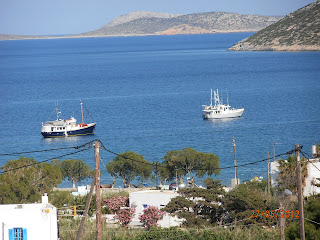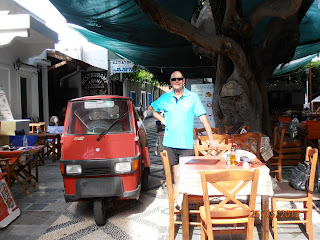Nordhavn 40 owner, Colin Rae, has posted the question on the blog “when you anchor out and go ashore, are there dinghy docks, or do you just tie the dinghy (tender) up somewhere convenient, or drag it ashore?” Well this has prompted a short dissertation about dinghies! Within a few days I’ll update the blog on our progress etc.
A suitable and robust tender is essential equipment for a live-aboard vessel. It greatly enhances safety and enjoyment, and serves varied uses including:
- Transport to and from shore for up to four people, not always in perfect conditions, often quite a distance from shore, and sometimes with visitors’ luggage.
- Carrying heavy loads, such as supplies, from shore typically with two people aboard.
- Recreational use – the boating life is all about fun, and a suitable tender adds immensely to your ability to safely explore places of interest nearby to the anchored mother-ship, to undertake diving or fishing trips etc.
- Taking lines ashore when mooring stern-to the shore, as is typical in many offshore destinations.
- Deploying and retrieving extra anchors or stern anchors.
- Helping to moor in tight spaces – if you have sufficient crew, one experienced can use the tender to help hold your vessel against the wind or push her into position.
- As an aid to safety, for example assisting in a man overboard situation, or as an additional life raft if weather and sea conditions allow its use.
- Acting as a platform for cleaning and doing maintenance work on the hull when at anchor.
What type of tender is best?
It wasn’t too many years ago that most tenders were traditional wooden dinghies, mostly rowed, but some also powered by small outboards.
Nowadays the tender market is totally dominated by Rigid Hull Inflatable Boats (RHIBs or RIBs. There is however some argument in favour of aluminium tenders where owners do a lot of fishing (fish dorsal spines can puncture inflatable pontoons), or pull their tenders up on very rocky beaches.
RHIBs have the huge benefits of excellent stability and load-carrying ability, robustness, light weight for size, being virtually unsinkable, being able to come alongside a vessel without causing damage, and ease of repair - there is no better testimonial to RHIB’s than their widespread adoption for police, military, search and rescue, and commercial work.
Their few disadvantages would be poor rowing performance compared with wooden or aluminium dinghies (particularly with passengers aboard), the danger of damage to inflatable pontoons in situations like contact with rocks or sharp protrusions from jetties, and long-term deterioration of the pontoons from the sun’s ultraviolet rays. The latter two issues can be mostly overcome by fitting “chaps” over the pontoons to protect them, and we have these on our larger RHIB.
Another disadvantage applicable only to small RHIBs compared with conventional dinghies, is they can be rather wet when powering into or across small, but choppy wind-driven seas. This does not apply to medium-sized, higher powered RHIBs which plane over the chop.
Envoy has two RHIBs - the larger one 3.7m long with a 25HP 4-stroke outboard, weighing all-up about 260kg, and a smaller one 2.7m long with a 2.3HP 4-stroke outboard, weighing about 35kg without the motor.
If we were to carry only one tender it would be our larger one as this has met all of our usage requirements, including planing with four people aboard, and being towed in winds up to 50 knots and seas to two metres without problems. But the weight of this RHIB represents its disadvantage, as it can only be launched and retrieved with our electric boom winch, and then only in calm conditions with light winds. For that reason we considered there was a safety risk in case of power failure, winch failure, cable breakage or bad weather, as well as an inconvenience, so we bought the second smaller RHIB.
Most of the time there are only two of us aboard Envoy, and then we normally use our 2.7m RHIB, which without the motor fitted, can easily be manually launched from Envoy’s foredeck by one person, and retrieved by two. This one is ideal for going ashore, and lifting out of the water onto a beach. There are no dinghy docks, except in the fanciest of marinas, so we are normally faced with beaching our RHIB or mooring to a rough concrete wall, or an equally rough wooden jetty with all kinds of sharp protrusions. For this reason fenders (buffers) are essential. Another option we sometimes use is to anchor the RHIB a short distance off the beach with a stern line ashore.
We’ve not had any security issues when leaving our tender, but do normally remove the ignition key (large RIB) or kill switch lanyard (small RIB).
A suitable and robust tender is essential equipment for a live-aboard vessel. It greatly enhances safety and enjoyment, and serves varied uses including:
- Transport to and from shore for up to four people, not always in perfect conditions, often quite a distance from shore, and sometimes with visitors’ luggage.
- Carrying heavy loads, such as supplies, from shore typically with two people aboard.
- Recreational use – the boating life is all about fun, and a suitable tender adds immensely to your ability to safely explore places of interest nearby to the anchored mother-ship, to undertake diving or fishing trips etc.
- Taking lines ashore when mooring stern-to the shore, as is typical in many offshore destinations.
- Deploying and retrieving extra anchors or stern anchors.
- Helping to moor in tight spaces – if you have sufficient crew, one experienced can use the tender to help hold your vessel against the wind or push her into position.
- As an aid to safety, for example assisting in a man overboard situation, or as an additional life raft if weather and sea conditions allow its use.
- Acting as a platform for cleaning and doing maintenance work on the hull when at anchor.
What type of tender is best?
It wasn’t too many years ago that most tenders were traditional wooden dinghies, mostly rowed, but some also powered by small outboards.
Nowadays the tender market is totally dominated by Rigid Hull Inflatable Boats (RHIBs or RIBs. There is however some argument in favour of aluminium tenders where owners do a lot of fishing (fish dorsal spines can puncture inflatable pontoons), or pull their tenders up on very rocky beaches.
RHIBs have the huge benefits of excellent stability and load-carrying ability, robustness, light weight for size, being virtually unsinkable, being able to come alongside a vessel without causing damage, and ease of repair - there is no better testimonial to RHIB’s than their widespread adoption for police, military, search and rescue, and commercial work.
Their few disadvantages would be poor rowing performance compared with wooden or aluminium dinghies (particularly with passengers aboard), the danger of damage to inflatable pontoons in situations like contact with rocks or sharp protrusions from jetties, and long-term deterioration of the pontoons from the sun’s ultraviolet rays. The latter two issues can be mostly overcome by fitting “chaps” over the pontoons to protect them, and we have these on our larger RHIB.
Another disadvantage applicable only to small RHIBs compared with conventional dinghies, is they can be rather wet when powering into or across small, but choppy wind-driven seas. This does not apply to medium-sized, higher powered RHIBs which plane over the chop.
Envoy has two RHIBs - the larger one 3.7m long with a 25HP 4-stroke outboard, weighing all-up about 260kg, and a smaller one 2.7m long with a 2.3HP 4-stroke outboard, weighing about 35kg without the motor.
If we were to carry only one tender it would be our larger one as this has met all of our usage requirements, including planing with four people aboard, and being towed in winds up to 50 knots and seas to two metres without problems. But the weight of this RHIB represents its disadvantage, as it can only be launched and retrieved with our electric boom winch, and then only in calm conditions with light winds. For that reason we considered there was a safety risk in case of power failure, winch failure, cable breakage or bad weather, as well as an inconvenience, so we bought the second smaller RHIB.
Most of the time there are only two of us aboard Envoy, and then we normally use our 2.7m RHIB, which without the motor fitted, can easily be manually launched from Envoy’s foredeck by one person, and retrieved by two. This one is ideal for going ashore, and lifting out of the water onto a beach. There are no dinghy docks, except in the fanciest of marinas, so we are normally faced with beaching our RHIB or mooring to a rough concrete wall, or an equally rough wooden jetty with all kinds of sharp protrusions. For this reason fenders (buffers) are essential. Another option we sometimes use is to anchor the RHIB a short distance off the beach with a stern line ashore.
We’ve not had any security issues when leaving our tender, but do normally remove the ignition key (large RIB) or kill switch lanyard (small RIB).

.JPG)


.JPG)
+-+Copy+-+Copy.JPG)
+-+Copy.JPG)
+-+Copy.JPG)
+-+Copy.JPG)
+-+Copy+-+Copy.JPG)
+-+Copy.JPG)
+-+Copy.JPG)

+-+Copy.JPG)
.JPG)
.JPG)
.JPG)
.JPG)




.JPG)
.JPG)
.JPG)


.JPG)
.JPG)
.JPG)




